|
|
Post by Roquefort Raider on Jun 22, 2019 18:24:42 GMT -5
Back at the end of the XXth century, Marvel decided to launch a new line, the Ultimate line, that would feature a rebooted Marvel Universe without the need for performing a Crisis on Marvel Earth. It was a way to have one’s cake and eat it too.
As a long-time Marvel reader, I was decidedly underwhelmed by the concept. The core reason given for the existence of the line, that the convoluted, decades-long continuity of the Marvel universe was preventing new readers from starting reading comics, struck me as particularly stupid. After all, I had started reading both Marvel and DC comics after they had already been around for a very long time, and their continuity was not a deterrent at all: it was something I absolutely wanted to dive into!
Naturally, continuity in comics is like any component of a recipe... too much of anything ruins the dish. Comics continuity is a good thing if it is used to enhance a story, referred to when useful, and quietly ignored when it is inconvenient. In a good writer’s hands, continuity is a great tool. Besides, rebooting a whole universe just leads to a new continuity which will become equally confusing in a matter of months, so...
But that’s neither here nor there. The line was launched, and titles like Ultimate Spider-Man proved very popular. (I tried Ultimate X-Men and thought it was an abomination, Heroes Reborn level, but that’s a discussion for another day).
A few years later, I decided to give that line’s version of The Avengers, The Ultimates, a chance... and picked the first trade paperback.
Ho-lee Moley.
What I found there was not a reboot of the Avengers... What I found was what could have been the basis for an actual Avengers movie; something that the future would confirm, as the MCU Avengers have much more in common with the Ultimates than with the old school Marvel Universe).
The Ultimates, at least the first two volumes written by Mark Millar (a writer whose work I am not generally a fan of, I must admit) do not read like the start of an ongoing series; they really read like what we now see on Netflix, with limited series that might or might not be renewed. Characters were familiar, being based on the heroes of our childhood (Thor, Cap, Iron Man, Nick Fury and the gang) but also reinterpreted in the same way that movie versions usually differ from their comic-book counterparts. There was not a feeling that this or that character would be safe from being killed next issue; the general tone of the series was that we were heading toward a proper ending, not setting things up for the next half-century. Anybody could die next issue. Like in the movies, we got references to classic stories, we got Easter eggs, but we weren’t bound by anything. The show was all that mattered!
The Ultimates had everything one loves about a blockbuster summer movie. Widescreen action! Holy #@$ moments! Pop culture references! Humour! Action! Things going kablooie!!!
I didn’t know about that Bryan Hitch fellow back then... (In hindsight, I did come across his art in a Ninjak annual, but had classified him as an Alan Davis clone). In The Ultimates, he provided absolutely gorgeous artwork, photorealistic but never stiff, everything I would have wanted to do when I started as a cartoonist (and everything I would have wanted to read as a kid). Reading The Ultimates and looking at the art, even considering that the book was very often late and that publishing realities have changed massively since the 80s, I couldn’t help thinking of the difference between this and the first subscription issues of the Avengers I got way back when, When I expected Perez and got a fill-in by Kupperberg... The Ultimates really feel like an actual movie printed on glossy paper.
So strap in, effendi, as we go back to what is arguably the root of the MCU, in the pages of that other version of the Avengers!
|
|
|
|
Post by codystarbuck on Jun 22, 2019 18:52:34 GMT -5
Yeah, I was cool with this series, though not wild about Hulk chasing Freddie Prinze Jr (really? The Hulk? Kind of stupid, but whatever) and wasn't cool with the idea that Captain America, a guy who is boosted to physical perfection for humanity, can survive a freefall from a plane. Cap was not a superman, in any form. That was where I started having reservations, even though it looked really cool. Wasn't keen on the way Cap was handled, politically; but, I was waiting to see how it would play out. Then, you know, Hank Pym, and Quicksilver & Scarlet Witch acting like Lannisters. Thenm "Do you think this A stands for France?!?"
Volume 1, I thought was mostly great; Vol 2? Well........
Looked purty, though!
Still not a fan of "widescreen" comics; but, Hytch makes it work better than most. Costume designers loved him for giving them practical ideas.
|
|
|
|
Post by Roquefort Raider on Jun 22, 2019 18:57:24 GMT -5
The Freddie Prinze Jr reference is symptomatic of what happens when a work of modern fiction tries to be “hip” or “cool” (to paraphrase Stan Lee) by making references to current pop culture artefacts or personalities... the work gets dated pretty darn quick! Re-reading the series today, I have to use Google to find out who Shannon Alexander might be.
That’s one of the problems with The Ultimates as a classic series, but it’s also part of its charm. Kind of like those atrocious puns and one-liners from 80s movies!
|
|
|
|
Post by codystarbuck on Jun 22, 2019 19:12:24 GMT -5
The Freddie Prinze Jr reference is symptomatic of what happens when a work of modern fiction tries to be “hip” or “cool” (to paraphrase Stan Lee) by making references to current pop culture artefacts or personalities... the work gets dated pretty darn quick! Re-reading the series today, I have to use Google to find out who Shannon Alexander might be. That’s one of the problems with The Ultimates as a classic series, but it’s also part of its charm. Kind of like those atrocious puns and one-liners from 80s movies! Oh, it was obvious what it was; a desperate plea to Hollywood to look our way. Worked pretty well, for both Marvel and Millar. Better than Stan's batting average, in Hollywood (aside from promoting himself). Some of Hytch's models were a bit of a chuckle. Thor looks like Hulk Hogan, with more hair and a more cut physique (Hogan never did learn to cycle his steroids properly). You could also tick off movie references, in some of the art, like the Matrix assault on the office building. Supreme Power seemed to follow the same model, including delayed issues. |
|
|
|
Post by Duragizer on Jun 23, 2019 3:21:02 GMT -5
My exploration of the Ultimate Universe never went very far. I checked out a number of Ultimate Spider-Man trades from the library back in the day, read them in random order, and that's pretty much it. I haven't re-read those stories (and with Bendis as writer, I'm not eagre to), and the reputation of the line has convinced me to give the other titles a wide berth.
|
|
|
|
Post by Deleted on Jun 23, 2019 3:51:12 GMT -5
I found Ultimate Spider-Man to be incredibly slow. And what was with the constant character poses on the covers? They hardly enticed me.
I checked out other "Ultiimate Universe" books. Only The Ultimates appealed to me. It was much better than I expected it to be, and I felt it was a page-turner (I bought them in trades). The Hollywood stuff was an example of them going overboard, but I found them to be eventful and solid books.
|
|
|
|
Post by Reptisaurus! on Jun 23, 2019 6:03:04 GMT -5
I really, really, really like the Ulitmates. I'm not sure anyone will ever do a better superhero comic in that 7-words-per-huge-panel style.
|
|
|
|
Post by Deleted on Jun 23, 2019 6:12:02 GMT -5
I am reading the Ultimate Galactus Trilogy right now. A slow-burner for sure, but I'm finding it to be compelling.
|
|
|
|
Post by thwhtguardian on Jun 23, 2019 8:27:11 GMT -5
I loved the whole Ultimate line right to the end. Although X-Men started off poorly it got much better after the questionable Ultumatum event.
|
|
|
|
Post by Roquefort Raider on Jun 23, 2019 10:37:24 GMT -5
The UltimatesVolume 1 Story by Mark Millar Art by Bryan Hitch and Andrew Currie, colours by Paul Mounts  Chapter one : Super-human Chapter one : Super-humanThis first issue is the equivalent of a pre-credit scene (something we see less and less of, now that action movies then to put their title at the end). The story (spoilers galore, naturally) : We open with a world war II scene, with American soldiers storming a German-held beach (very much in the Saving Private Ryan tradition). This time, however, we are not in Normandy but in Iceland, and the year in 1945… near the end of the war. Aboard a B-24 Liberator (no “generic propeller plane” in this book), American paratroopers prepare for the drop. We meet this universe’s version of Bucky Barnes, a photojournalist who has followed the career of Captain America during the entire war; Bucky used to save Steve Rogers from beatings when they were kids in Brooklyn. Another soldier is one Kowalski, unimpressed by the presence of Captain America, whom he views as little else than a propaganda prop. Overhearing the man griping, Cap self-assuredly states that he never lost a crew in three years of covert operations, and that he invites them all to his impending wedding to one Gail Richards. Richards? Is she somehow related to Reed Richards? That is not alluded to here. (Personally I would really avoid too much continuity this early in the game). As the drop begins, someone notices that Cap isn’t wearing a parachute (a scene reused in the Winter Soldier movie). Bucky quips that Cap thinks parachutes are for girls, a comment probably judged offensive by whoever wrote the movie’s final script. (I thought it was pretty funny… it’s exactly the kind of schoolyard talk that boys pumping their chest would use). The German target is a huge industrial complex, heavily defended, and it takes Cap crashing an airplane into its massive doors to break them open. The Americans rush in, with Cap at their head: his uniform is not a super-hero costume but a more practical looking outfit (with an actual helmet). That look would also be used in the MCU movies. Notice that Cap used his triangular shield for the whole war. And he uses guns. He's really a super-soldier, emphasis on soldier. (I especially like small details like the canteen) 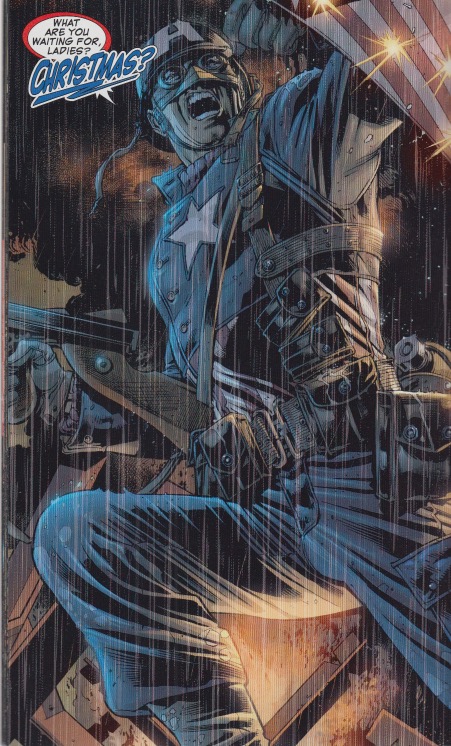 The German complex hosts a launching pad with a decidedly anachronistic rocket in it; when Bucky wonders where the Nazis got their "Flash Gordon tech", Cap answers that there are more sides fighting this war than one would suspect. We genre readers suspect that the nazis must be in cahoots with space aliens, a concept I really do not care about… The old conspiration theory according to which we reverse-engineered flying saucers to create microwave ovens or the internet strikes me as silly, because we know exactly how microwaves and the internet were developed and because they do not demand extraordinary leaps in technology. It’s as if in a wild west story someone said that we got the technology for revolvers from space alien. But anyway. The nazis have a space-age rocket, and since the war seems to be lost, they intend to nuke Washington D.C. (Bucky mentions that even if Oppenheimer gets results next month at Los Alamos, the allies will never have something that compares to that rocket… which strikes me as odd: how would a photojournalist know about the A-bomb project? I would have expected the Manhattan project to be top-secret… and if Bucky is cleared for that info on account of his being Cap’s friend, why doesn’t he know about the aliens? 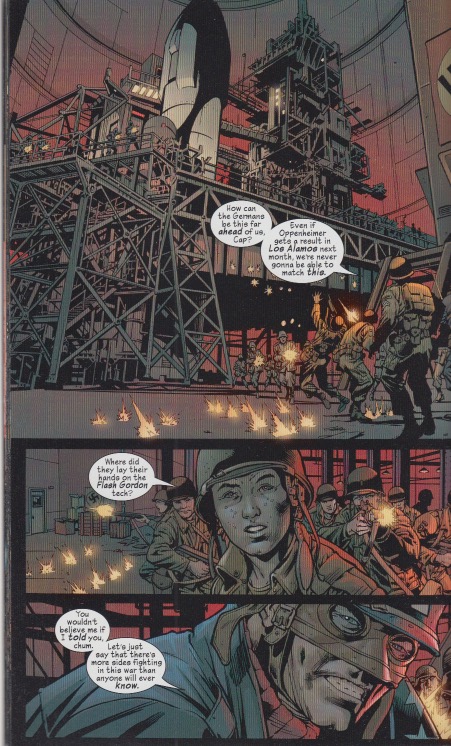 The rocket is launched as in Captain America’s original origin, except that this time he’s the only one riding it. While Bucky begs him (by radio) to jump off, Cap sacrifices himself by tearing open the rocket’s siding and dropping grenades inside. The explosion causes the bomb to malfunction and a nuclear explosion ensues. 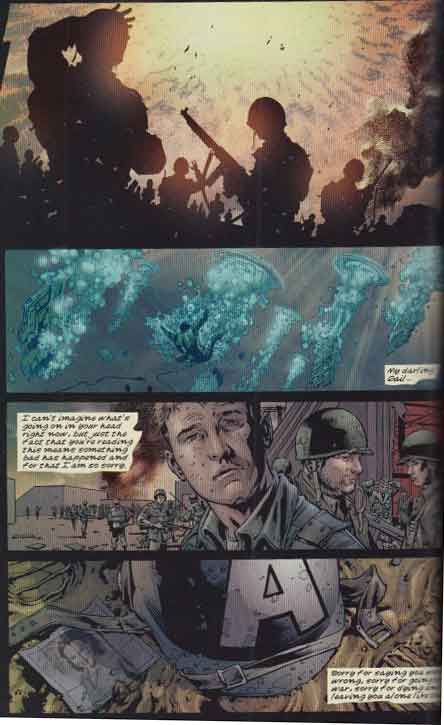 (That helmet will be back in a later issue!) Cap falls in the water, apparently dead. Great, great vacant look in his eyes here, and his gentle sinking is very poignant after the hyperkinetic action scenes that preceded it. 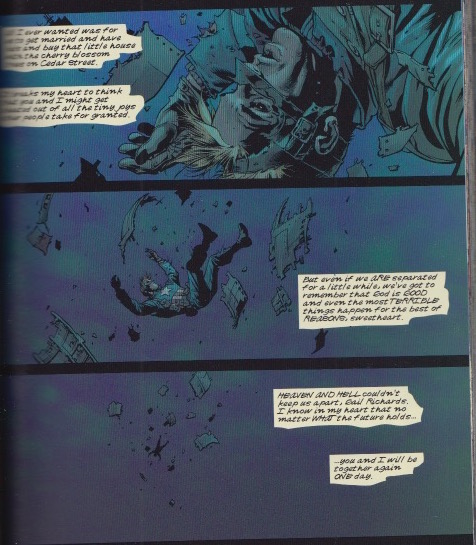 Fade to black, and we turn our attention to the modern and hip world of 2002. Industrialist Tony Stark (looking very much like Johnny Depp) is on Mt. Everest, having just concluded a hipster-style six-week fast. He mentions an important plan that will be set in motion the very next day, as he returns to the U.S. Overall appreciation :As first issues go, this does the job and more. Although it’s really a retelling of Captain America’s origin, it is dynamic and draws us in as any good action film should do. The characters aren’t that developed yet, but we still get a few glimpses of them being more than cyphers: the exchanges between Bucky and Kowalski add a lot of humanity to the script. (Kowalski may grumble a lot, but he’s someone we can really relate to… He’s not a super-human and really doesn’t want to get shot, but he’s ready to do what has to be done. My earlier reservations regarding the alien’s influence on nazi tech will be tempered somewhat later in the series, as we’ll learn that there weren’t that many of them during WWII. Perhaps they weren’t that good with technology themselves, being abl;e to offer generaladvice to German scientists but not being able to produce the actual plans for an H-bomb. The artwork, as stated before, is gorgeous. I would definitely have come back for the second issue had I picked up the first one.
|
|
|
|
Post by Roquefort Raider on Jun 23, 2019 12:30:55 GMT -5
The Ultimates Volume 1 Story by Mark Millar Art by Bryan Hitch and Andrew Currie, colours by Paul Mounts Chapter two : BigThis issue, we meet more members of our cast and start to learn what makes them tick. It is clear that while they are all inspired by the classic Marvel characters, they are meant to be new creations with which the writer can do as he pleases. We start with Nick Fury, director of SHIELD, who had already been introduced in a previous issue of Ultimate X-Men (and with two eyes, if I recall correctly). Here he is drawn as actor Samuel L. Jackson, wearing Nick’s traditional eyepatch. As everyone knows now it is because of this appearance in the comics that Jackson would later make the role his own. (I really can’t imagine Fury as anyone else than Jackson, now!)  Nick is having a business lunch with Bruce Banner, who in this reality is something of an unkempt and weaselly fellow. Banner was in charge of re-creating the serum that created Captain America in the 40s, and from what I understand it is the product of his research that inadvertently caused him to turn into the Hulk. (That happened in another title, and is not explained fully here… not that we need it, as comic-book readers. I guess that had this been a movie we’d have skipped the previous appearance of the Hulk and would have seen Banner undergo the transformation for the first time right in this story). The Hulk has earlier caused heavy damage to the city, as we can see in a nice panoramic shot, but his being Bruce Banner is not public knowledge. 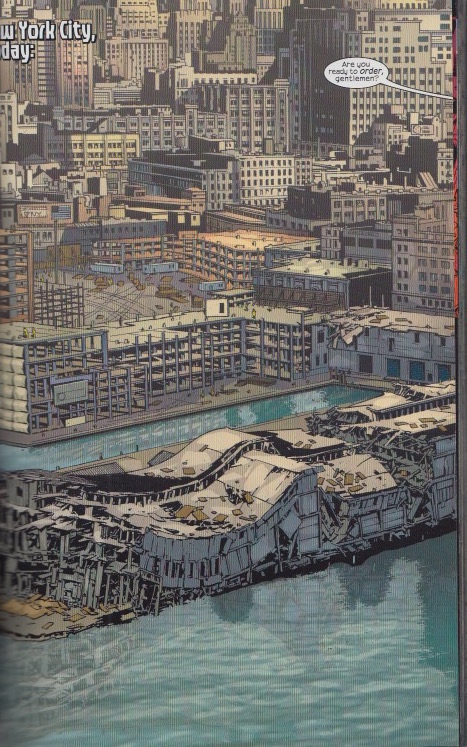 It seems that Banner is now under control, although he uses a lot of medication. Mention is made of the nazis’ alien tech having helped jump-start NASA. Ugh. Come on, that’s pretty insulting to the actual people who sent us to the moon. Besides, if alien tech was limited to rockets and to punch card and magnetic tape computers, it must have been at the low end of the spectrum! Banner is excited to learn that the government has allowed massive funds for the recreation of Captain America (which is seemingly his lifelong dream), but due to his condition he is being demoted to number two as the project’s chief scientist. Segue to the project’s original facility, a rather small lab in Pittsburgh. Now that the government wants super-soldiers, the place is moving to a new base being constructed in New York Harbour. The project’s newly-appointed top scientist, Henry Pym, is having ants help move crates around; he has developed a way to communicate with them and to order them around. We also meet his wife, Janet. 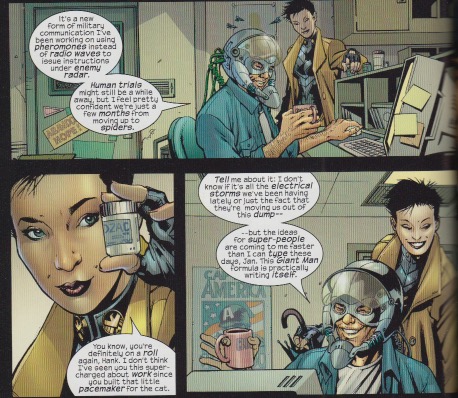 This time around, Jan isn’t a bubbly heiress; she’s a scientist as well, and we’ll learn later that her ability to shrink, to grow wings like a wasp and to shoot little bolts of electricity are not the result of her using some serum but are due to her being a mutant. It is in fact by studying his wife’s ability that Hank Pym came up with most of his ideas. In a later issue they will self-deprecaciously refer to themselves as a couple of hopeless science nerds with no social life, but their looking like lingerie and underwear model makes that hard to believe. The two seem to have a playful and healthy relationship, but we see that Hank uses prozac. Shades of the infamous slap secne in that old issue of the Avengers...It may be seen as unfortunate that the meme “Hank Pym as a bipolar abuser” seems to have crossed over to the Ultimates universe (and we’ll see that it is even ratcheted to eleven here), but as these are new characters… why not? It’s unfortunate for the legacy of that classic character, but as far as this particular story goes, it works quite well. Easter egg time: the helmet that Hank uses to communicate with ants is similar to the classic Ant-Man one. Time to properly introduce our next character: Tony Stark. This Stark is a lot like the Robert Downey Jr. version we got in the movie, but is far less of a loner. Brilliant and excentric, he’s also very much an alcoholic, chugging down martinis at 10 in the morning. He’s still functional, though. 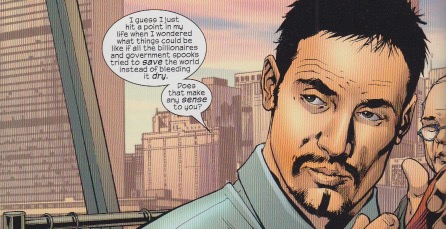 No secret identities in this book; Iron Man isn’t a persona, it’s something like a fancy flying car. It looks far more like a machine than like a super-costume. Again, that’s an approach that will be emulated by the movies (and by the MU Iron Man, come to think of it). 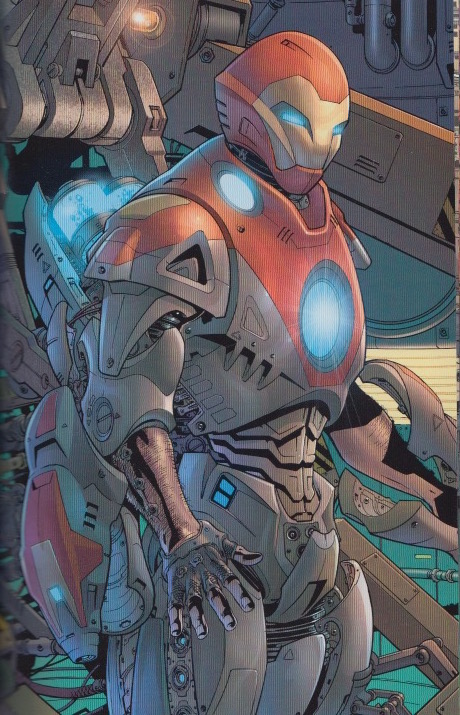 Jarvis is introduced as a flamboyantly gay older fellow. He remains a remarkable butler in whatever reality we're in; in one scene he serves Tony his drink as the man gets out of his armour, and when Stark gets to his office (several floors away) while talking to Fury, he finds Jarvis already there with his business clothes ready. Still putting our toys in place, we next move to the building site of the New York laboratory, which is to be called the Triskelion. It is sometimes said to be five miles away from Manhattan, but hardly seems more than a mile away from the Statue of Liberty (perhaps it’s a lens focus thing?) Janet Pym welcomes Banner and congratulates him on his engagement to Betty Ross, who used to be her roommate at the university. Betty is now in charge of communications for the project, and is the daughter of Fury’s old boss, "Thunderbolt" Ross (whom we knew as the Hulk’s nemesis in the old Marvel Universe, and who seems to be dead in this one). Unfortunately, Bruce and Betty are on a “relationship break”, which Banner takes very hard. Although people stay polite around him, it’s pretty obvious that everybody looks down on Banner. He, in turn, clearly suffers from self-image issues… which are exacerbated by the contrast between Pym’s continued success and his own failure to reproduce the super serum. Speaking of Pym’s successes, he next tests his Giant-Man process on himself (something of a trope in science-fiction stories, but decidedly not something you’d see in real life). Isolated in a test room while he grows, Pym pretends to suffer from a horrible transformation (“I’m turning inside out!”) to pull his colleagues’ tail; as they rush to help him, he greets them with a s%$-eating grin and a “gotcha, su%$#$s”). All sixty feet of him.  Everyone is relieved and cheers at the experiment’s success, except for Banner… who clearly feels that with every sucess met by others, his own star (and self-respect) fades. Banner keeps having flashes of the Hulk… in the form of which he definitely inspired respect. The meaning of chapter's title, "Big", is therefore manifold: it describes Pym's Giant-Size process, Banner's feeling anything but big, and what it means to "make it big" in a competitive environment. This will have a major impact later on. The issue concludes with Fury calling Banner and announcing that the body of the original Captain America was found frozen in the Arctic ocean. 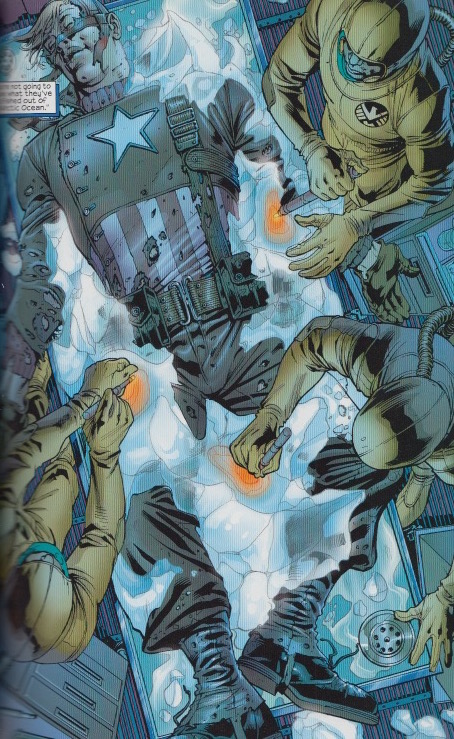 Not a whole lot of action this time around, although the Giant-Man experiment was certainly dramatic. (Giant-Man’s clothes don’t grow with him, by the way). We get a lot of world build-up, and our cast is almost complete. A few references date the book; Tony has a date with Cameron Diaz, Fury tells Banner to break open the bottle of champagne he kept for the next season of Star Trek, and he makes references to diet soda being poisoned by aspartame. That’s something I haven’t heard discussed in a very long time. |
|
|
|
Post by Roquefort Raider on Jun 23, 2019 15:10:17 GMT -5
The Ultimates Volume 1 Story by Mark Millar Art by Bryan Hitch and Andrew Currie, colours by Paul Mounts Chapter three : 21st century boyThe third episode focuses on Captain America and his arrival in the XXIst century. It might be entirely accidental, but it’s ironic to see an issue focusing on how Cap is a man out of his time thrown into a “modern” era, and having several outdated technology items be prominently shown! “Hey, look, outdated WWII veteran! We now have cell phones with buttons, man! We have camcorders to film our holidays! I make the analogy between this comic-book series and a Netflix series, and in that sense it’s kind of funny to see how brands are prominently displayed (Sony, Siemens) as if this comic was indulging in product placement the way Hollywood does. 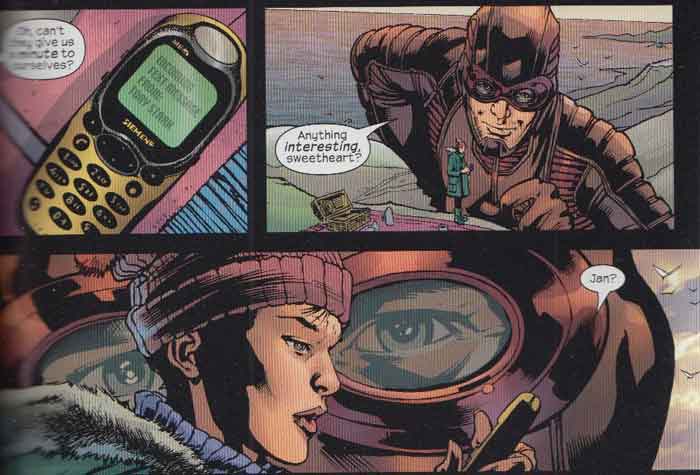 So Captain America is thawed, but upon waking up he’s convinced that the nazis are playing a trick on him. What tipped him off? General Nick Fury, a black man above the rank of captain! (I love that misunderstanding. Not because Cap is a racist, but because he’s still a man from the 1940s.) I suppose that being tied to his bed (for his own good, no doubt) didn’t do much to assuage his doubts. He promptly escapes his hospital room… 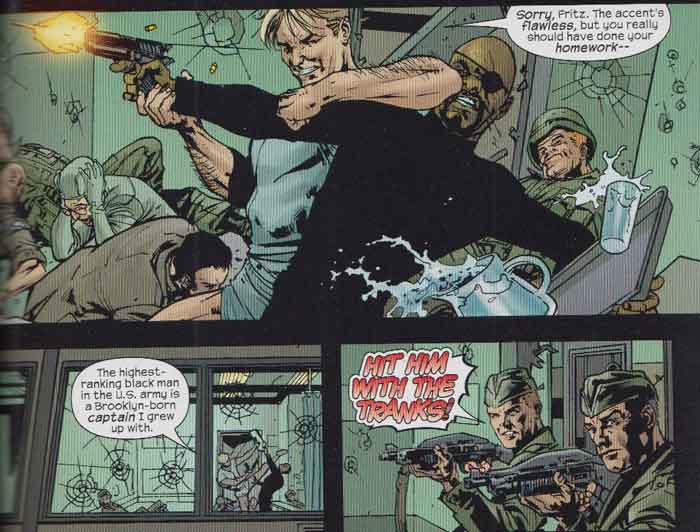 …but is caught by Hank Pym. There’s a funny moment when everyone thinks Cap is dead, crushed like a bug!  Little character moment: Bruce Banner tries some optimistic banter, but is rebuffed like the unpopular kid at school. We also learn that the lovey-dovey pair of Hank and Jan may not have an ideal marriage, as they view the Ultimates project as a fresh start for their relationship. Not a lot of exposition, but enough to get us to understand how these characters click. That's one of the strengths of this comic: it isn't verbose. Like a movie script, it really cuts to the chase. We are spared the traditional scene of “how can I been frozen for so long, what am I going to do and blablablah” and skip straight to Steve Rogers paying a visit to Bucky and Gail (Steve’s erstwhile fiancée). Bucky and Gail got married while Steve was frozen, and now the couple has four kids and seven grandkids. Bucky also has cancer. Cosmic coincidence time (a term that will actually be used in the series) : Fury mentions that his nose “has been smashed more times than Robert Downey Junior”. What was meant as just another (gratuitous) pop culture reference ties the name of the actor to the series, years before he would be cast as the perfect silver screen Tony Stark. Easter egg or continuity overdose: Bucky and Gail have a daughter called Sharon. In the Marvel Universe, Sharon Carter was the sister (later niece, and maybe even later great-great-grand-niece) of Peggy Carter, both ladies having been Cap’s girlfriend at different times in his life. Here, although no romantic link is established between Steve and Sharon, we still have a family link between Steve’s WWII lady-love and a modern-day Sharon. Nice touch: Sharon’s kids are biracial. The world has changed since 1945. Bucky is of course overwhelmed. How do you face your best friend, whom you’ve thought dead for fifty years, when you have sort of “betrayed” him by marrying his girlfriend? It’s a touching moment… 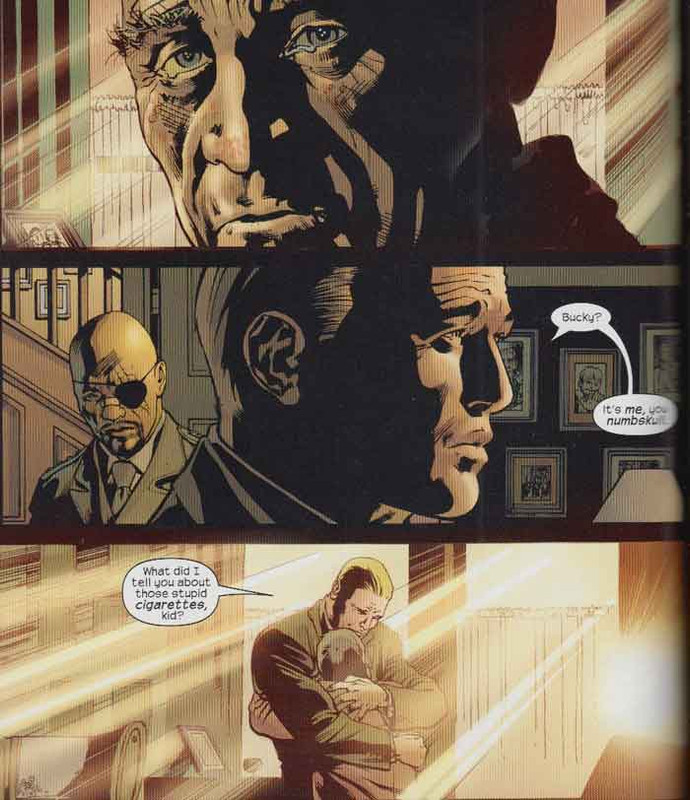 … a moment that’s made even more tragic when Gail finds herself unable to face her old fiancé, finding herself too old and ugly. That’s a heart-wrenching scene. (Gail has a strong character; she’s actually angry at Steve for volunteering back in the day, against her own counsel! What a lady!)  Steve finds himself basically alone. His parents died while he was on ice, as did his brother; one nephew was shot by narcotics officer, and his sole surviving niece does not know him at all. But there is still America, as Fury reminds him, and it still needs saving! That’s it for Cap’s moaning his fate, honest! Next time we see him, it’s at the grand opening of the Triskelion, which was designed by Norman Foster. That’s name-dropping, sure, but as Mr. Foster is a respected architect we’ll allow it… especially because it’s followed by the mention of Jennifer Tilly (actress and poker player), twinkies cake and Oprah Winfrey. It’s not that all these references don’t work… but they often feel forced, and many of them really date the material. Anyway, the Triskelion does look great. 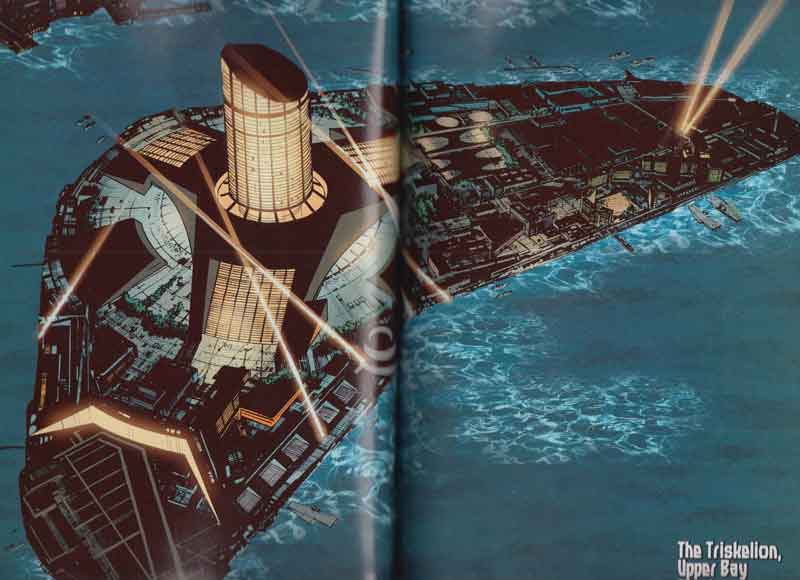 And look who’s there, among all the stars!  (Not sure I like this sort of gag as it’s a bit distracting, but I guess some people would find it pretty funny). Funnier is seeing George W. Bush refusing a pretzel on the following page. (President Bush once famously choked on one, and would understandably be prudent around them).  Although Bush is played for a buffoon here, one aspect of the Ultimates I always found admirable is that Millar’s politics are really, really subdued. In many, many instances, it is a conservative viewpoint that is presented as the right one. I would have expected a lot of America-or Conservative-bashing, but on the contrary found in this book a very sympathetic view on both (though not a blindingly approving one). We’ll go over such instances in more details in later issues. The episode concludes with the presentation of Captain America in his updated uniform, looking more like a proper super-hero outfit. He’s also got a new shield, courtesy of Janet and Hank’s work. |
|
|
|
Post by Reptisaurus! on Jun 23, 2019 15:22:19 GMT -5
I forgot the first issue was just Cap. Kinda cool (and daring!) to do a straight War comic in the first issue, with only tangental nods to super-hero tropes.
|
|
|
|
Post by hondobrode on Jun 23, 2019 15:28:53 GMT -5
As much as I have disliked Marvel for roughly 20 years now, I was a big fan of the Ultimate U, warts and all, and Ultimates was the best.
Of course Miles survived Secret Wars and is in the current 616, hardly a surprise, but I'm now reading on CBR that the Ultimate U is coming back.
I have next to zero faith in current Marvel so I'll be watching, and listening for word, on how it is.
Not holding my breath but hopeful.
|
|
|
|
Post by Roquefort Raider on Jun 23, 2019 16:06:02 GMT -5
The Ultimates Volume 1 Story by Mark Millar Art by Bryan Hitch and Andrew Currie, colours by Paul Mounts Chapter four : ThunderTime to introduce another member of our cast: the Asgardian god Thor! He’s not around much, though. We open with Tony Stark in a Stark Enterprises orbital station, where he’s taking a few days off with actress Shannon Elizabeth, because we need to use as many real-world names to make the comic trendy or something. Interviewed by Larry King (see above), Stark mentions on air how disappointing it is that Bruce Banner failed to recreate the super-serum that created Captain America. This public humiliation helps push Banner deeper into depression. Steve Rogers is acclimating to modern life, but insists on renting a small flat in his old (and now seedy) neighbourhood and hunting down his old vinyl LPs. Jan helps him shop, and Cap is charmingly uncomfortable being with another man’s wife. Jan has to explain a few things about life in the XXIst century, clearly more cheerful around him than around Banner. When it turns out Cap’s apartment was broken into and vandalized, the pair go break some heads (which happens off-page). Speaking of Banner: Betty Ross scolds him for letting the Pyms walk over him, and blames him for everything that’s going wrong in her day. Banner confesses soto voce that he’s losing his mind, but she doesn’t pay attention. The depressed scientist next accompanies Fury in Norway, where they want to recruit a certain Thor, god of thunder. This Thor is more of a hippie than a warrior god. He’s an anti-establishment, anti-military, pro-nature activist, with dozens of followers with hoodies and body piercings, all drinking beer on the beach. He also kind of looks like Mickey Rourke, but that will not last.  Thor really comes across like a bit of a fake, but he does know things that Banner never told anyone and he does command the lightning. He refuses Fury’s offer, and when the general counters that he thought Thor was here to save the world, the thunder god counters with “Oh, I am here to save the world, General Fury. From people like you”. Ominous? Perhaps, but this tree-hugging surfer dude doesn’t appear to be bad at heart. He drinks Miller beer, though, so what kind of Asgardian god can he be? I don't think it's too early to mention that I think the treatment of Thor by Millar is one of the very high points of The Ultimates. This series is really set in the "real" world, if you make exception for amazingly advanced tech and alien species; I mean that there is not a hint of magic anywhere. Thor being an alien would be one thing (as in the MCU), but an actual god -and a Norse god to boot- is harder to believe. Millar will really use that ambiguity, providing evidence that Thor is not a god at all, but a Norwegian nurse who had a nervous breakdown and stole some strength-enhancing harness and weather-contoling technology. We will be kept in the dark for the entire two volumes, and I for one really enjoyed the carefully maintained uncertainty! After than little fiasco, the Ultimates find themselves with fewer members than they originally intended. Chewing the fat and discussing things like movie options, they engage in a very Tarentino-esque exchange on who should play them on the big screen. Fury would be played by Samuel L. Jackson, naturally, Cap by Brad Pitt (he doesn't get that reference), and Jan is annoyed that she’d be played by Lucy Liu, since the two look nothing alike. Then Hank starts on who could play the bug-eyed neuroticism of Banner, but unfortunately Bruce walks into the room at that exact moment, leaving it in a hurry, apparently distraught. Typical case of “open mouth, insert foot”.  This cruel jest has massive repercussions. Later that night, Banner calls Betty (who’s having dinner with <popculturereference> Fredie Prinze Jr.</popculturereference> who wants to volunteer to become the next Captain America, because he wants to be a super-hero more than <popculturereference> Nicholas Cage</popculturereference>. Banner admits having mixed his own super-soldier serum with some of Cap’s blood and having injected himself with it, admitting that he did it because he missed being big. He was pushed over the edge. 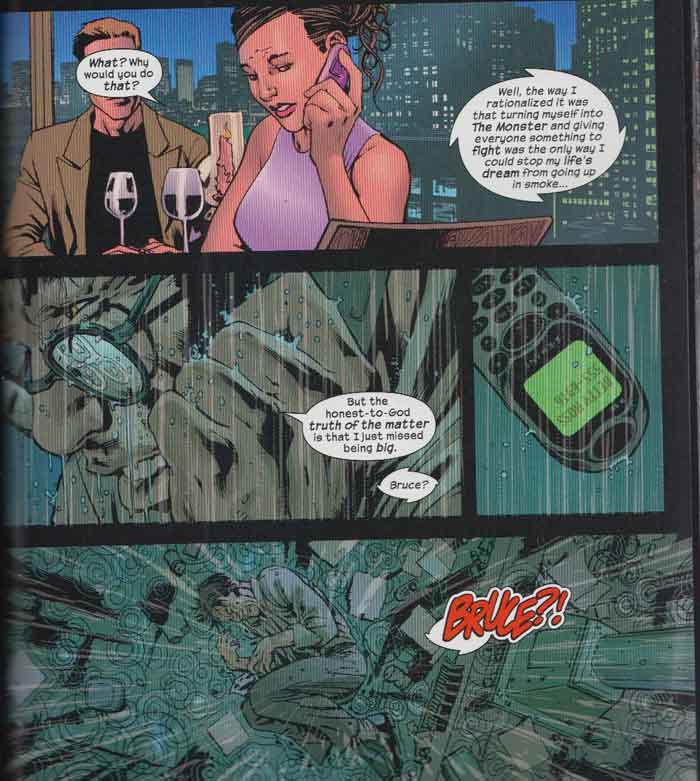 Banner collapses in the rainy street but is rescued by an ambulance. He goes into cardiac arrest but then turns into the Hulk… a huge, gray, savage Hulk. A Hulk who “wants Freddie Prinze Junior”. Notified of the event, the Ultimates suit up and we see more hints of friction between Jan and Hank, as she blames him for being cruel to Banner and he replies by saying she started it. Agree with this depiction of Pym or not, one has to admit that the depiction of a dysfunctional couple is pretty accurate. After four issues setting things up, we are now ready to rumble!  |
|

























